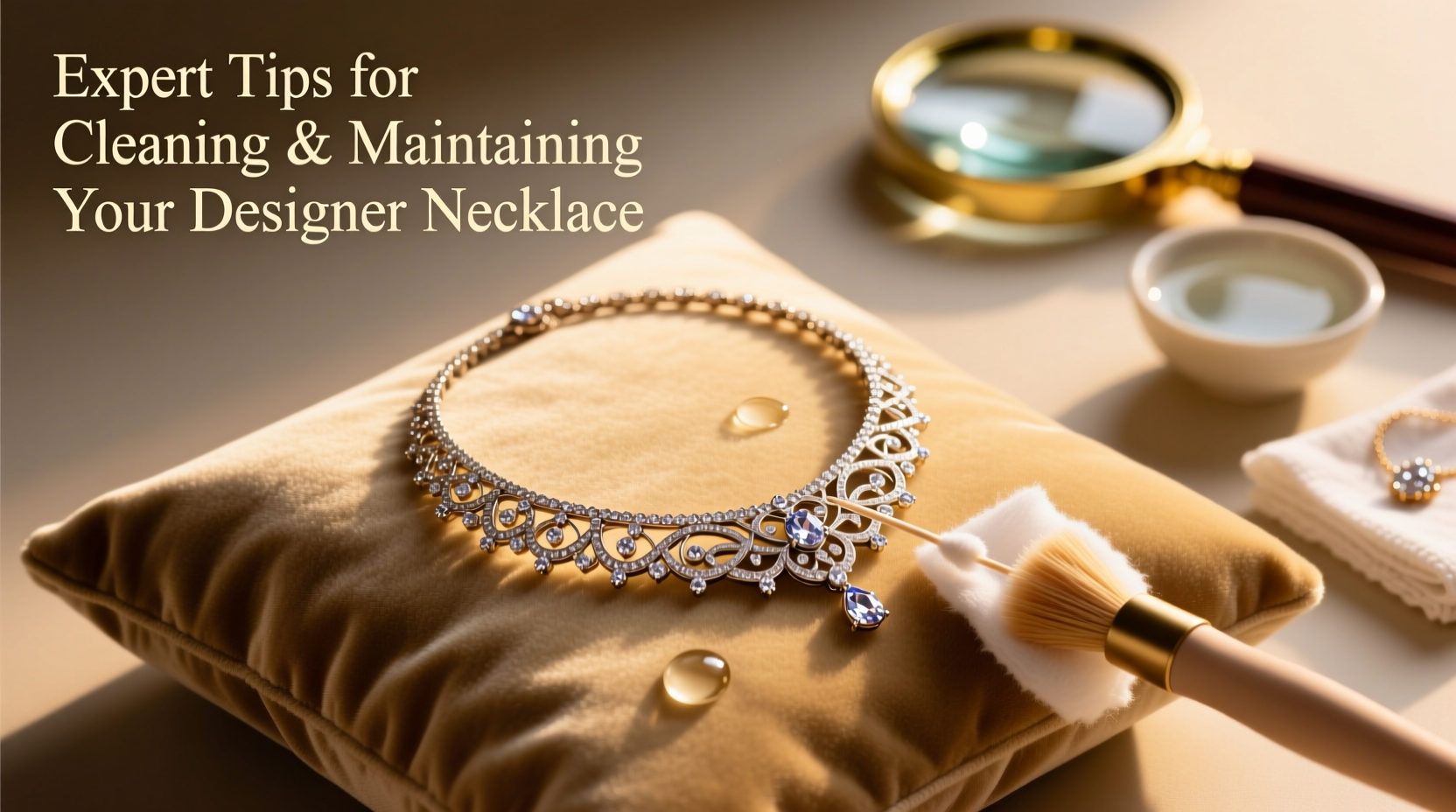A designer necklace is more than just an accessory—it’s a statement of elegance, craftsmanship, and personal style. Whether it’s a delicate gold chain, a diamond pendant, or a vintage-inspired piece, its brilliance can fade without proper care. Dust, oils from the skin, perfumes, and environmental exposure all contribute to dullness and wear over time. But with consistent, informed maintenance, you can preserve its luster and extend its life for decades. This guide delivers practical, expert-backed strategies to keep your designer necklace looking radiant and new.
Understand Your Necklace’s Materials

Not all necklaces are created equal. The cleaning and care methods depend heavily on the materials used—gold, silver, platinum, gemstones, pearls, or enamel. Each has unique sensitivities.
- Gold (yellow, white, rose): Resistant to tarnish but can scratch and accumulate grime in crevices.
- Silver: Prone to tarnishing due to sulfur exposure in air and skin oils.
- Platinum: Durable and hypoallergenic, but develops a patina over time that some prefer polished away.
- Gemstones: Diamonds are hardy; emeralds, opals, and pearls require gentler handling.
- Pearls: Organic and porous—avoid water, chemicals, and ultrasonic cleaners.
Step-by-Step Guide to Cleaning Your Designer Necklace
Cleaning doesn’t have to be complicated, but it must be done carefully. Follow this sequence to avoid damage while restoring shine.
- Remove the necklace before activities: Take it off before showering, swimming, exercising, or applying cosmetics.
- Prepare a cleaning solution: Mix a few drops of mild dish soap with warm (not hot) water in a small bowl.
- Soak gently: Place the necklace in the solution for 15–20 minutes to loosen dirt and oils.
- Brush softly: Use a soft-bristled toothbrush (preferably unused) to lightly scrub around settings, chains, and clasps.
- Rinse thoroughly: Hold under lukewarm running water using a strainer to prevent loss.
- Dry completely: Pat dry with a lint-free microfiber cloth. Never air-dry on fabric that may snag fine chains.
- Inspect regularly: Check for loose stones, worn prongs, or weakened links after cleaning.
“Many clients bring in damaged pieces simply because they used abrasive cloths or soaked pearls. A little knowledge goes a long way.” — Rafael Mendez, Master Jeweler & GIA Graduate
Do’s and Don’ts: What to Avoid at All Costs
Mistakes in jewelry care are often irreversible. Use this table as a quick reference to protect your investment.
| Do’s | Don’ts |
|---|---|
| Wipe your necklace with a soft cloth after wearing | Use bleach, chlorine, or ammonia-based cleaners |
| Store in a lined jewelry box or anti-tarnish pouch | Leave it exposed to sunlight or humidity |
| Have clasps and settings inspected annually | Wear during household chores or exercise |
| Keep pearls last in your dressing routine | Soak pearls or porous gemstones in water |
| Use a professional ultrasonic cleaner only if approved for your stone type | Store multiple necklaces tangled together |
Proper Storage: The Silent Guardian of Shine
How you store your necklace matters as much as how you clean it. Poor storage leads to tangling, scratching, and accelerated tarnishing.
Chains, especially fine ones, are prone to kinking and breaking when left in disarray. Gemstone settings can knock against harder metals, loosening stones over time. Humidity accelerates oxidation, particularly in silver.
For optimal storage:
- Use individual soft pouches or fabric-lined compartments.
- Hang longer necklaces on a padded stand to prevent tangling.
- Include anti-tarnish strips in drawers or boxes, especially for silver.
- Avoid plastic bags—they can trap moisture and cause chemical reactions.
Real Example: How One Client Saved a Heirloom Piece
Clara inherited a 1920s Art Deco platinum and diamond necklace from her grandmother. Initially, she wore it weekly without removing it at night or during showers. Within six months, the diamonds appeared cloudy, and the clasp felt loose.
She brought it to a trusted jeweler, who explained that daily exposure to lotions and sweat had built up residue in the settings. Worse, the constant stress on the clasp had weakened the solder.
After a professional cleaning and clasp reinforcement, Clara adopted a strict care routine: wiping after wear, storing in a velvet box, and scheduling biannual inspections. Two years later, the necklace sparkles as brightly as the day it was restored—and Clara now shares her story with other collectors.
Essential Maintenance Checklist
Stay proactive with this monthly and annual checklist to ensure your designer necklace remains in top condition.
Monthly Actions
- Perform a gentle at-home cleaning.
- Inspect for loose stones or damaged links.
- Wipe with a polishing cloth (for gold/silver).
Annually
- Schedule a professional inspection and deep clean.
- Check prongs, clasps, and chains for wear.
- Consider re-plating if rhodium or gold plating has worn (common in white gold).
Frequently Asked Questions
Can I use jewelry cleaning wipes every day?
No. While convenient, most wipes contain mild chemicals that can build up over time and dull metal or damage soft stones. Reserve them for occasional touch-ups, not daily use.
How often should I professionally clean my necklace?
Twice a year is ideal for frequently worn pieces. If worn occasionally, once a year suffices. High-exposure environments (beach, gym, city pollution) warrant more frequent service.
Is it safe to swim with a gold necklace?
No. Chlorine in pools and salt in seawater can corrode metal and weaken solder joints. Even “water-resistant” does not mean “safe for immersion.” Always remove before swimming.
Final Thoughts: Care Is a Form of Appreciation
Your designer necklace reflects taste, memory, and sometimes, legacy. Treating it with care isn’t just about preserving value—it’s a sign of respect for the artistry behind it. Simple habits like wiping after wear, storing properly, and scheduling professional checkups compound into years of radiant beauty.









 浙公网安备
33010002000092号
浙公网安备
33010002000092号 浙B2-20120091-4
浙B2-20120091-4
Comments
No comments yet. Why don't you start the discussion?